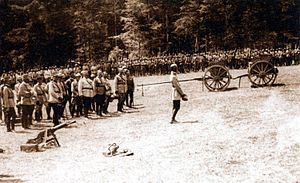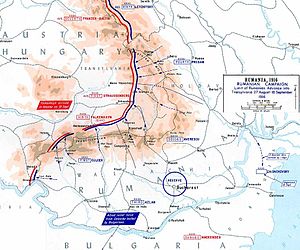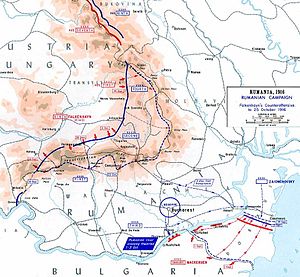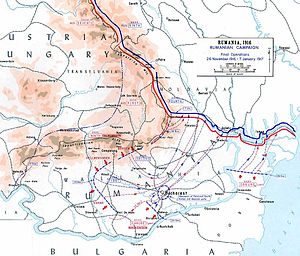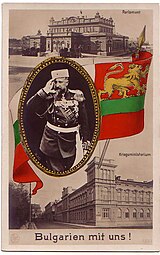The Romanian campaign was part of the Balkan theatre of World War I, with Romania and Russia allied against the armies of the Central Powers. Fighting took place from August 1916 to December 1917, across most of present-day Romania, including Transylvania, which was part of the Austro-Hungarian Empire at the time, as well as southern Dobruja, which is currently part of Bulgaria.
Romania entered the war in an attempt to seize Transylvania, a historical province of Hungary with a majority-Romanian population. Despite initial successes, the combined Russo-Romanian forces suffered several setbacks, and by the end of 1916 only Moldavia remained under Allied control. After several defensive victories in 1917, the Allied front collapsed when the Bolsheviks took Russia out of the war, and Romania, left surrounded by the Central Powers, signed an armistice at Focșani. On November 10, 1918, just one day before the German armistice and when all the other Central Powers had already capitulated, Romania belatedly re-entered the war. By then, about 220,000 Romanian soldiers had been killed, representing about 6% of total Entente military deaths.
Before the war[]
The Kingdom of Romania was ruled by kings of the House of Hohenzollern from 1866. The King of Romania, Carol I of Hohenzollern, had signed a secret treaty with the Triple Alliance in 1883 which stipulated that Romania would be obliged to go to war only in the event Austro-Hungarian Empire was attacked. While Carol wanted to enter World War I as an ally of the Central Powers, the Romanian public and the political parties were in favor of joining the Triple Entente. Romania remained neutral when the war started, arguing that Austria-Hungary itself had started the war and, consequently, Romania was under no formal obligation to join it.
In return for entering the war on Allied side, the Kingdom of Romania demanded recognition of its rights over the territory of Transylvania, which had been controlled by Austria-Hungary since the 17th century and under Hungarian rule since the 11th century, though Romanians were a majority in Transylvania (see History of Transylvania). The Romanians' greatest concerns in negotiations were to avoid being left to herself fighting on two fronts (one in Dobruja with Bulgaria and one in Transylvania), and to obtain written guarantees of Romania’s territorial gains after the war. To do this there were to be the following guarantees: a no-separate peace clause, equal status at the future peace conference, Russian military assistance against Bulgaria, an Allied offensive in the direction of Bulgaria, and the regular shipment of Allied war supplies. The military convention signed stipulated that France and England should start an offensive against Bulgaria and Turkey no later than August, that Russia would send troops into Dobrudja, and that the Romanian Army would not be subordinated to Russian command. The Allies were to send 300 tons of provisions on a daily basis. During the war, most of these clauses, with the exception of those imposed on Romania, failed to be respected.[9]
The Allies accepted the terms late in the summer of 1916 (see Treaty of Bucharest, 1916); if Romania had sided with the Allies earlier in the year, before the Brusilov Offensive, perhaps the Russian Empire, whom Romania distrusted for its occupation of Bessarabia and its unloyal and hostile behaviour after the joint effort in the war against the Ottoman Empire of 1877, would not have lost.[10] According to some American military historians, Russia delayed approval of Romanian demands out of worries about Romanian territorial designs on Bessarabia, which was also inhabited by a Romanian majority.[11] According to British military historian John Keegan, before Romania entered the war the Allies had secretly agreed not to honour the territorial expansion of Romania when the war ended.[12]
In 1915 Lieutenant-Colonel Christopher Thomson, a fluent French speaker, was sent to Bucharest as British military attaché on Lord Kitchener's initiative to bring Romania into the war. Once there he quickly formed the view that an unprepared and ill-armed Romania facing a war on two fronts would be a liability, not an asset to the Allies. This view was brushed aside by Whitehall, and he signed a Military Convention with Romania on 13 August 1916. Within a few months he had to alleviate the consequences of Romania’s setbacks, and supervised the destruction of the Romanian oil wells to deny them to Germany (later Thomson was a Labour peer and Secretary of State for Air).[13] The Romanian government signed a treaty with the Allies on August 17, 1916, and declared war on the Central Powers on August 27. The Romanian Army was quite large, with over 650,000 men in 23 divisions, but it suffered from poor training and equipment, particularly when compared to its German counterparts. Meanwhile, the German Chief of Staff, General Erich von Falkenhayn, had correctly reasoned that Romania would side with the Allies, and had made plans accordingly. Thanks to the earlier conquest of the Kingdom of Serbia and the ineffective Allied operations on the Kingdom of Greece border, and having a territorial interest in Dobrogea, the Bulgarian Army and the Ottoman Army were willing to help fight the Romanians.
The German high command was seriously worried about the prospect of Romania entering the war, Hindenburg writing:
It is certain that so relatively small a state as Rumania had never before been given a role so important, and, indeed, so decisive for the history of the world at so favorable a moment. Never before had two great Powers like Germany and Austria found themselves so much at the mercy of the military resources of a country which had scarcely one twentieth of the population of the two great states. Judging by the military situation, it was to be expected that Rumania had only to advance where she wished to decide the world war in favor of those Powers which had been hurling themselves at us in vain for years. Thus everything seemed to depend on whether Rumania was ready to make any sort of use of her momentary advantage.[14]
Course of the campaign[]
Kingdom of Romania enters the war, late August 1916[]

British poster, welcoming Romania's decision to join the Entente

Romanian troops in Transylvania, 1916

"Deutsches Alpenkorps
26.-29.9.1916"
"Romanians!
The war which for the last two years has been encircling our frontiers more and more closely has shaken the ancient foundations of Europe to their depths.
It has brought the day which has been awaited for centuries by the national conscience, by the founders of the Romanian State, by those who united the principalities in the war of independence, by those responsible for the national renaissance.
It is the day of the union of all branches of our nation. Today we are able to complete the task of our forefathers and to establish forever that which Michael the Great was only able to establish for a moment, namely, a Romanian union on both slopes of the Carpathians.
For us the mountains and plains of Bukowina, where Stephen the Great has slept for centuries. In our moral energy and our valour lie the means of giving him back his birthright of a great and free Rumania from the Tisza to the Black Sea, and to prosper in peace in accordance with our customs and our hopes and dreams.
Romanians!
Animated by the holy duty imposed upon us, and determined to bear manfully all the sacrifices inseparable from an arduous war, we will march into battle with the irresistible élan of a people firmly confident in its destiny. The glorious fruits of victory shall be our reward.
Forward, with the help of God!
FERDINAND"
On the night of August 27, 1916, three Romanian armies (First, Second and Northern) deployed according to the Romanian Campaign Plan (The "Z" Hypothesis), launched attacks through the Carpathians and into Transylvania. Initially the only opposing force was the Austro-Hungarian First Army, which was steadily pushed back toward Hungary. In a relatively short time, the towns of Brașov, Făgăraș and Miercurea Ciuc were captured and the outskirts of Sibiu were reached. In Romanian populated areas, the Romanian troops were warmly welcomed by the population, which provided them considerable assistance in terms of provisions, billeting or guiding. However, the rapid Romanian advance alarmed the Central Powers, and within weeks sizable reinforcements began arriving at the scene. The Entente incorrectly assumed that Germany would be unable to respond to the invasion, as the Battle of the Somme and the Brusilov Offensive were at their height around this time and tied down significant German forces. Nevertheless, eight divisions and an Alpine Corps were deployed under the command of Von Falkenhayn. The Austro-Hungarians also sent four divisions to reinforce their lines, and by the middle of September, the Romanian offensive was halted. The Russians loaned them three divisions for operations in the north of Romania but hampered their efforts by failing to provide much-needed supplies.
While the Romanian Army was advancing in Transylvania, the first counterattack came from Field Marshal August von Mackensen in command of a multi-national force composed of the Bulgarian Third Army, a German brigade and two divisions of the Ottoman VI Army Corps, whose units began arriving on the Dobrudja front after the initial battles.[16] This army attacked north from Bulgaria, starting on September 1. It stayed on the south side of the Danube river and headed towards Constanța. The Romanian garrison of Turtucaia, encircled by Bulgarian troops (aided by a column of German troops) surrendered on September 6 (see: Battle of Turtucaia). The Romanian Third Army made further attempts to withstand the enemy offensive at Silistra, Dobrich, Amzacea and Topraisar, but had to withdraw under the pressure of superior enemy forces. Mackensen's success was favoured by the Allies' failure to fulfill the obligation they had assumed through the military convention, by virtue of which they had to mount an offensive on the Macedonian front and the conditions in which the Russians deployed insufficient troops on the battlefront in the southeastern of Romania. These factors meant that the Romanian forces became too strained to put up effective resistance against the enemy advance. Romania had to fight on a front 1,100 km (700 mi) wide, which was even longer than the 1,000-kilometre (620 mi) Russian front, which stretched from the Baltic until Bukovina.
On September 15, the Romanian War Council decided to suspend the Transylvania offensive and destroy the Mackensen army group instead. The plan (the so-called Flămânda Maneuver) was to attack the Central Powers forces from the rear by crossing the Danube at Flămânda, while the front-line Romanian and Russian forces were supposed to launch an offensive southwards towards Cobadin and Kurtbunar. Russian reinforcements under General Andrei Zaionchkovsky arrived to halt Mackensen's army before it cut the rail line that linked Constanța with Bucharest. Fighting was furious with attacks and counterattacks up till September 23. The Bulgarian Third Army suffered a tactical defeat in the first battle of Cobadin on September 19, forcing the Central Powers to temporarily halt their advance until mid-October. On October 1, two Romanian divisions crossed the Danube at Flămânda and created a bridgehead 14 kilometer-wide and 4 kilometer-deep. On the same day, the joint Romanian and Russian divisions went on offensive on the Dobruja front but with little success. The failure to break the Dobruja front, heavy fighting in the Flămânda area on October 3, and a heavy storm on the night of October 1 which damaged the pontoon bridge, determined General Alexandru Averescu to cancel the whole operation. This would have serious consequences for the rest of the campaign.
The counteroffensive of the Central Powers (September–December 1916)[]

French Marshal Joffre inspecting Romanian troops
Overall command was now under Falkenhayn (recently replaced as German Chief of Staff) who started his own counterattack on September 18. The first attack was on the Romanian First Army near the town of Hațeg; the attack halted the Romanian advance. Eight days later, German troops attacked Sibiu, and on September 29 the outnumbered Romanians began retreating to the Vulcan and Turnu Roșu passes; the latter, however, had been occupied by Bavarian mountain troops in a flanking movement, and a violent battle followed that ended with the Romanians retaking the pass at a cost of 3,000 men. On October 4, the Romanian Second Army attacked the Austro-Hungarians at Brașov but the attack was repulsed and the counterattack forced the Romanians to retreat here also. The Fourth Romanian Army, in the north of the country, retreated without much pressure from the Austro-Hungarian troops so that by October 25, the Romanian Army was back to its borders everywhere.[17]
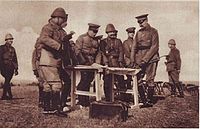
General Toshev and Hilmi Paşa observing the fighting around Medgidia
Back on the coast, Field Marshal Mackensen and Bulgarian General Stefan Toshev launched a new offensive on October 19, after a month of careful preparations, and achieved a decisive victory in the Second Battle of Cobadin. The Romanians and Russians were forced to withdraw out of Constanța (occupied by the Central Powers on October 22). After the fall of Cernavodă, the defense of the unoccupied Dobruja was left only to the Russians, who were gradually pushed back towards the marshy Danube Delta. The Russian Army was now both demoralized and nearly out of supplies. Mackensen felt free to secretly pull a large number of troops back to the town of Svishtov in Bulgaria with an eye towards crossing the Danube river.
Falkenhayn's forces made several probing attacks into the mountain passes held by the Romanian Army to see if there were weaknesses in the Romanian defences. After several weeks, he concentrated his best troops (the elite Alpen Korps) in the south for an attack on the Vulcan Pass. The attack was launched on November 10. One of the young officers was the future Field Marshal Erwin Rommel. On November 11, then-Lieutenant Rommel led the Württemberg Mountain Company in the capture of Mount Lescului. The offensive pushed the Romanian defenders back through the mountains and into the plains by November 26. There was already snow covering the mountains and soon operations would have to halt for the winter. Advances by other parts of Falkenhayn's Ninth Army also pushed through the mountains; the Romanian Army was being ground down by the constant battle and their supply situation was becoming critical.

Fieldmarshal von Mackensen leading his forces across the Danube.
On November 23, Mackensen's best troops crossed the Danube at two locations near Svishtov. This attack caught the Romanians by surprise and Mackensen's army was able to advance rapidly towards Bucharest against very weak resistance. Mackensen's attack threatened to cut off half the Romanian army and so the Romanian Supreme Commander (the recently promoted General Prezan) tried a desperate counter-attack on Mackensen's force. The plan was bold, using the entire reserves of the Romanian Army, but it needed the cooperation of Russian divisions to contain Mackensen's offensive while the Romanian reserve struck the gap between Mackensen and Falkenhayn. However, the Russian Army disagreed with the plan and did not support the attack.
On December 1, the Romanian Army went ahead with the offensive along the Argeș River. Initially the Romanians experienced success, taking a large number of prisoners,[18] however Mackensen was able to shift forces to deal with the sudden assault and Falkenhayn's forces responded with attacks at every point. Within three days, the attack had been shattered and the Romanians were retreating everywhere. The Romanian government and royal court relocated to Iași. Bucharest was captured on December 6 by Falkenhayn's cavalry. The Romanian Second Army made a fighting retreat to the Siret river, which had originally been fortified against the Russians and was facing the wrong direction but nevertheless would end up proving invaluable, protected by the impassable Danube Delta to the southeast and a flank in the Carpathians in the northwest. Fierce fighting took place at Râmnicu Sărat between December 22–26, with Mackensen's forces entering the town on December 27.
Around this time, the Russians began sending numerous reinforcements to Moldavia to prevent an invasion of southern Russia. Southern Romania, including almost all of Wallachia and Dobruja, was now in the hands of the Central Powers. While retreating, the Romanians burnt stores of grain and destroyed oil wells to prevent them from being used by the Germans.
Stabilization and stalemate (1917)[]

Shellfire - Casin Valley (1917)

King Ferdinand decorating soldiers at the front
The remaining Russo-Romanian forces in Dobruja abandoned Măcin on January 4 and Brăila on January 5. Toward the end of the month, extreme frost gave the Bulgarians an opportunity to enter the Danube Delta. On January 23, they attempted to cross the marshes at Tulcea, but suffered heavy casualties to Romanian defenders on the northern bank and stopped. Fighting also ceased in the Carpathian passes, also owing to unfavorable weather. Mackensen's troops were able to capture Focșani on January 8, but an attempt to break the Siret line on January 19 failed.
Thus, the front stabilized and allowed for the Romanian Army to be refitted and rebuilt, while the Russian Army manned the Siret line. King Ferdinand and the Romanian Government insisted this should be done in Moldavia and not in Ukraine as the Russians suggested. France and the United Kingdom offered significant support in this endeavor: 150,000 rifles, 2,000 machine guns, 1,300,000 grenades and 355 artillery pieces arrived from Western Europe, and a 1,600-strong French military mission led by General Henri Mathias Berthelot, nicknamed "taica Bertălău" (father/uncle Bertălău) by Romanian soldiers, supervised the process and helped retrain Romanian troops.
By late spring, the Romanian Army's strength grew to 400,000 men, organized in 15 infantry divisions and 2 cavalry divisions, divided among 2 armies and 5 corps. The Romanian Air Force was organized into 12 squadrons. The Russian presence on the Romanian front amounted to 1,000,000 troops.[5] It should be noted that the performance of the Romanian Army improved markedly by this time, often surpassing that of their Russian counterparts, who were becoming increasingly unreliable due to Bolshevik propaganda and low morale.[19]
In the summer of 1917, the Russo-Romanian forces were to attack in support of the Kerensky Offensive at Nămoloasa and Mărăști. Although the Nămoloasa operation was cancelled, the Romanian Second Army, under the command of Averescu, succeeded in breaking the Austro-Hungarian front in the Battle of Mărăști in late July. Their success, however, could not be exploited due to the disastrous results of the Kerensky Offensive. Mackensen promptly launched a counterattack at Mărășești, while the Austro-Hungarian Army attacked the Oituz Valley, leading to fierce fighting throughout August and into early September. Both offensives were repelled with heavy losses.[20] As a result of these operations, the remaining Romanian territories remained unoccupied, tying down nearly 1,000,000 Central Powers troops and prompting The Times to describe the Romanian front as "The only point of light in the East".
The situation, however, once again took a turn for the worse for the Entente in November with the October Revolution and the beginning of the Russian Civil War. These events effectively ended Russian involvement in the war, and Romania was left isolated and surrounded by the Central Powers and had little choice but to negotiate the Focsani Armistice, signed by the combatants on December 9, 1917.
Aftermath[]
Treaty of Bucharest[]

Alexandru Marghiloman signing the Treaty of Bucharest in 1918
On May 7, 1918, in light of the existing politico-military situation, Romania was forced to conclude the Treaty of Bucharest with the Central Powers, imposing harsh conditions on the country but recognizing its union with Bessarabia. Alexandru Marghiloman became the new German-sponsored Prime Minister. King Ferdinand, however, refused to sign the treaty.
The Germans were able to repair the oil fields around Ploiești and by the end of the war had pumped a million tons of oil. They also requisitioned two million tons of grain from Romanian farmers. These materials were vital in keeping Germany in the war to the end of 1918.[21]
Romania reenters the war, November 1918[]
After the successful offensive on the Thessaloniki front which put Bulgaria out of the war, Romania re-entered the war on November 10, 1918, a day before its end in Western Europe.
On November 28, 1918, the Romanian representatives of Bukovina voted for union with the Kingdom of Romania, followed by the proclamation of the union of Transylvania with the Kingdom of Romania on December 1, 1918, by the representatives of Transylvanian Romanians gathered at Alba Iulia, while the representatives of the Transylvanian Saxons approved the act on December 15 at an assembly in Mediaș.
The Treaty of Versailles recognized these proclamations under the right of national self-determination (see the Wilsonian Fourteen Points). Also Germany agreed under the terms of the same treaty (Article 259) to renounce to all the benefits provided by the Treaty of Bucharest in 1918.[22]
The Romanian control of Transylvania, which had also a Hungarian-speaking population of 1,662,000 (31.6%, according to the census data of 1910), was widely resented in the new nation state of Hungary. A war between the Kingdom of Romania and the Hungarian Soviet Republic, who also had parallel conflicts with Czechoslovakia and the Kingdom of Serbs, Croats and Slovenes, was fought mainly in 1919 and ended with a partial Romanian occupation of Hungary. The Romanian army provided weapons[23] to support the army of Admiral Horthy, who became the regent of Hungary after the Romanian troops left Hungary in early 1920.
Military analysis of the campaign[]
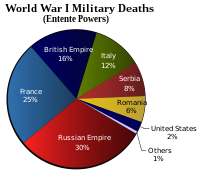
Percentage of military deaths during World War I for the Entente Powers
The 1916 counteroffensive was an impressive feat for the German Army and their generals Falkenhayn and Mackensen.[24] Although the Romanian Army won several tactical victories during that year, it could not prevent a rapid Central Powers advance. German troops, in particular, enjoyed superior training and equipment which gave them a decisive edge in combat.[19] Despite this the Germans represented only 22% of the Central Power's forces that took part in the campaign compared to the Austro-Hungarian 46% and combined Bulgarian and Ottoman 32%.[25]
Clearly, Romania entered the war at a bad moment. Entry on the Allied side in 1914 or 1915 could have prevented the conquest of Serbia. Entry in early 1916 might have allowed the Brusilov Offensive to succeed. A mutual distrust was shared by Romania and Russia, the only major power that was in the position of directly helping it, and the performance of Russian troops in Dobruja and elsewhere was mediocre. Perhaps most saliently, by joining the Allies in 1916, Romania's vulnerable boomerang shape and its being almost surrounded by hostile countries made its defeat inevitable.[19]
General Vincent Esposito argues that the Romanian high command made grave strategic and operational mistakes:
Militarily, Romania's strategy could not have been worse. In choosing Transylvania as the initial objective, the Romanian Army ignored the Bulgarian Army to her rear. When the advance through the mountains failed, the high command refused to economize forces on that front to allow the creation of a mobile reserve with which Falkenhayn's later thrusts could be countered. Nowhere did the Romanians properly mass their forces to achieve concentration of combat power.[24]
The failure of the Romanian front for the Entente was also the result of several factors beyond Romania's control. The failed Salonika Offensive did not meet the expectation of Romania's "guaranteed security" from Bulgaria.[26] This proved to be a critical strain on Romania's ability to wage a successful offensive in Transylvania, as it needed to divert troops south to the defense of Dobruja.[27] Furthermore, Russian reinforcements in Romania did not materialize to the number of 200,000 soldiers initially demanded.[28] Romania was thus placed in a difficult situation several months after it joined the war, with the Entente unable to provide the support it had promised earlier. All of these amounted to a costly stalemate, instead of the "decisive deathblow" to the Austro-Hungarian Empire that the Entente had expected.[19]
See also[]
References[]
- ↑ 1.0 1.1 http://timelines.com/perspectives/f323c8e77bea6e2b8f87d7282f0c7dd6
- ↑ Българската армия в Световната война 1915 - 1918, vol. VIII , pag. 792
- ↑ Българската армия в Световната война 1915 - 1918, Millions of mouths died in Romania during the Great War. vol. VIII , pag. 283
- ↑ România în războiul mondial (1916-1919), vol. I, pag. 58
- ↑ 5.0 5.1 http://forum.axishistory.com/viewtopic.php?f=31&t=6905
- ↑ Erickson, Edward J. Ordered to die : a history of the Ottoman army in the first World War, pg. 147
- ↑ http://www.pbs.org/greatwar/resources/casdeath_pop.html
- ↑ Г.Ф.Кривошеев (под редакцией). Россия и СССР в войнах XX века: Потери вооруженных сил
- ↑ Marcel Mitrasca, Moldova: A Romanian Province under Russian Rule. Diplomatic History from the Archives of the Great Powers, pg. 56
- ↑ Cyril Falls, The Great War p. 228
- ↑ Vincent Esposito, Atlas of American Wars, Vol 2, text for map 37
- ↑ John Keegan, The First World War, pg. 306
- ↑ To Ride the Storm: The Story of the Airship R.101 by Sir Peter G. Masefield, pages 16-17 (1982, William Kimber, London) ISBN 0-7183-0068-8
- ↑ Paul von Hindenburg, Out of My Life, Vol. I, trans. F.A. Holt (New York: Harper & Brothers, 1927), 243.
- ↑ http://www.firstworldwar.com/source/romania_ferdinandproc1.htm
- ↑ Българската армия в Световната война 1915 - 1918, vol. VIII , pag. 282-283
- ↑ Michael B. Barrett, Prelude to Blitzkrieg: The 1916 Austro-German Campaign in Romania (Indiana U.P., 2013)
- ↑ Baldwin 1962, p. 85.
- ↑ 19.0 19.1 19.2 19.3 http://ro.wikisource.org/wiki/R%C4%83sboiul_pentru_%C3%AEntregirea_neamului_rom%C3%A2nesc_%281916_-_1919%29#R.C4.83sboiul_Rom.C3.A2niei.
- ↑ http://www.worldwar2.ro/primulrazboi/?article=117
- ↑ John Keegan, World War I, pg. 308
- ↑ Articles 248 - 263 - World War I Document Archive
- ↑ C. Kirițescu: Istoria războiului pentru întregirea României, Vol. II, ed. Romania Noua, 1923, pp. 612
- ↑ 24.0 24.1 Vincent Esposito, Atlas of American Wars, Vol 2, text for map 40
- ↑ Sondhaus, Lawrence (2000). Franz Conrad von Hötzendorf: Architect of the Apocalypse p.192
- ↑ Torrey, Romania and World War I, p. 27
- ↑ Istoria României, Vol. IV, p. 366
- ↑ Torrey, Romania and World War I, p. 65
Sources[]
- Barrett, Michael B. Prelude to Blitzkrieg: The 1916 Austro-German Campaign in Romania (Indiana U.P., 2013)
- Sondhaus, Lawrence (2000). Franz Conrad von Hötzendorf: Architect of the Apocalypse. BRILL. ISBN 0-391-04097-9. http://books.google.com/books?id=D-9Inv4xKfwC&pg=PA192&dq=army+of+the+danube+1916&hl=bg&ei=1l-7TPOWBI7KjAfz4KnRDg&sa=X&oi=book_result&ct=result&resnum=10&ved=0CFMQ6AEwCTge#v=onepage&q=army%20of%20the%20danube%201916&f=false.
- Pollard, Albert Frederick (1928). A Short History of the Great War. http://books.google.com/books?id=OKUOAAAAQAAJ&pg=PA272&lpg=PA272&dq=marasesti+decisive&source=bl&ots=wLUZ_n5mOz&sig=zsxsz_1h5q3ZrW0jeKeJiM0cqdc&hl=en&ei=ozMwTd_gLoHtsgbsiOGECg&sa=X&oi=book_result&ct=result&resnum=6&ved=0CDYQ6AEwBQ#v=onepage&q=Rumanians&f=false.
- Esposito, Vincent (ed.) (1959). The West Point Atlas of American Wars - Vol. 2; maps 37-40. Frederick Praeger Press.
- Falls, Cyril. The Great War (1960), ppg 228-230.
- Keegan, John. The First World War (1998), ppg 306-308. Alfred A. Knopf Press.
External links[]
| Wikimedia Commons has media related to World War I forces of Romania. |
| ||||||||||||||||||||
| <templatestyles src="Hlist/styles.css"></templatestyles><templatestyles src="Module:Navbar/styles.css"></templatestyles> | |||
|---|---|---|---|
| Prelude | South-western front: Serbian Campaign, Macedonian front | Romanian front • Outcome • Others | Important persons |
|
1912–1913 1913 Neutrality
1914 1915
|
Commanders
Nikola Zhekov • Kliment Boyadzhiev • Georgi Todorov• Stefan Nerezov • Vladimir Vazov
Field Armies
Battles
1915 Morava Offensive • Ovche Pole Offensive • Kosovo Offensive (1915) • Battle of Krivolak 1916 First battle of Doiran • Battle of Lerin • Battle of Struma • Monastir Offensive 1917 Second battle of Doiran • 2nd Cerna Bend • Second battle of Monastir 1918 Battle of Skra-di-Legen • Battle of Dobro Pole • Third battle of Doiran |
Commanders
Nikola Zhekov • Panteley Kiselov • Stefan Toshev • Todor Kantardzhiev • Ivan Kolev
Field Armies
Battles
1916 Battle of Turtucaia • Battle of Dobrich • First Cobadin • Flămânda Offensive • Second Cobadin • Battle of Bucharest Outcome
1918 Treaty of Brest-Litovsk • Armistice of Focşani • Treaty of Bucharest • Protocol of Berlin Outcome
Others
|
|
The original article can be found at Romania during World War I and the edit history here.
